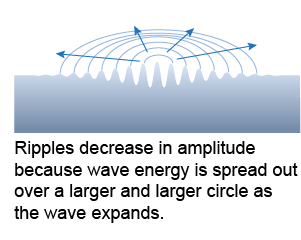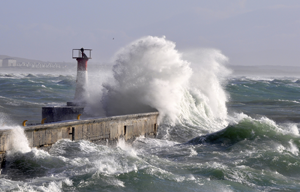|
When a wave travels through matter some of the wave’s energy is dissipated through processes we loosely call “friction.” This loss of energy is more properly called absorption. Absorption describes the transformation of wave energy into other forms of energy that occurs when a wave travels through matter. Absorption at some level affects virtually all waves, including sound, light, water, and even seismic waves. One of the few exceptions is an electromagnetic wave, such as visible light, traveling through a pure vacuum. Light waves can travel through the vacuum of space across the known universe without significant absorption. 
|

|
As a wave is absorbed, the amplitude of the wave decreases. Except in special cases the frequency remains the same. How quickly the amplitude decreases depends on both the type of wave and the medium the wave is moving through. For example, a sponge absorbs water waves within a fraction of a wavelength, but it transmits sound waves through several centimeters. Theaters often use thick heavy curtains to absorb sound waves so that the audience cannot hear backstage noise. The tinted glass in sunglasses absorbs some energy from light but still passes enough to see by. 
|
 Wave amplitude may decrease for reasons other than absorption. For example, when a circular ripple spreads out, the amplitude of the ripple decreases with increasing distance from the center. This decrease mostly results from the wave’s energy being distributed over a larger area as the wave expands. Circular and spherical waves share this characteristic because both distribute wave energy over an increasing area as they spread.
Wave amplitude may decrease for reasons other than absorption. For example, when a circular ripple spreads out, the amplitude of the ripple decreases with increasing distance from the center. This decrease mostly results from the wave’s energy being distributed over a larger area as the wave expands. Circular and spherical waves share this characteristic because both distribute wave energy over an increasing area as they spread. 
|
 The energy of a wave is transferred to the material that absorbs the wave. With water waves this effect is dramatically illustrated by the power of hurricanes. When a large wave hits the shore, all of its energy is released quickly. This energy may be enough to move cars and trucks and demolish roads and houses. With other types of waves the absorbed energy is often converted to heat.
The energy of a wave is transferred to the material that absorbs the wave. With water waves this effect is dramatically illustrated by the power of hurricanes. When a large wave hits the shore, all of its energy is released quickly. This energy may be enough to move cars and trucks and demolish roads and houses. With other types of waves the absorbed energy is often converted to heat. 
|
| |
|

